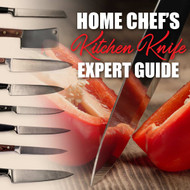Home Chef's Kitchen Knife Expert Guide
2019 Feb 25th
What can we say? Williams Food Equipment has all things cutlery! When you are in the market for an everyday knife, such as, a Zwilling J.A. Henckels Bagel Knife or a butter spreader to smear that cold cream cheese or butter on your bagel, Williams has it! Or, maybe you are in need of a more professional knife, such as, an Omcan Spinning Shawarma/ Kebab Knife, a 20” Wusthof Stainless Bone Saw, Williams brings everything for the cooking novice or for professional chefs.
Often when shopping for knives, the place to start is to determine your cooking style, preferences, types of food and skill level. Not every knife is considered equal and shopping for a knife is not an easy task. Today’s technology has blended knives of all shapes and sizes into the strength and art form of both Eastern and Western craftsmanship. Japanese and German knives are regarded as some of the best knives in the world, however, making a decision to make that big purchase of a knife depends on a number of things; what will it be used for, brand, material it is made from, and forged vs stamped are always the top questions asked about cutlery
What is the differences between Japanese and German knives? Both are of the utmost quality and precision. Japanese knives are some of the sharpest knives drawing their craftsmanship from Samurai swords. German knives have a stronger and thicker blade. The main differences are in design based on which has a bolster, a tang, the angle of the blade and the thickness of the metal. Japanese knives can cut paper thin slices versus their German counterpart. Though, if you are cutting into a pumpkin, German knives win hands down. German knives are considered the workhorse of knives and are utilitarian, while Japanese knives are for finer, more delicate slicing.
Many Japanese knives have started to mirror their German counterparts by manufacturing knives that can be used in everyday cooking. Our first knife, the Santoku, is a Japanese knife whose name indicates the tasks of; mincing, slicing, and dicing. Usually between 5 to 8 inches in length, a chisel-tip (due to Japanese knives having a single bevel), and only a 15 max angle. The lesser angle of the blade makes straight chopping and dicing quicker. Also, they are super sharp and lighter due to the hardness of steel employed in fabricating this knife and this is one of my favorite knives! It’s my workhorse!
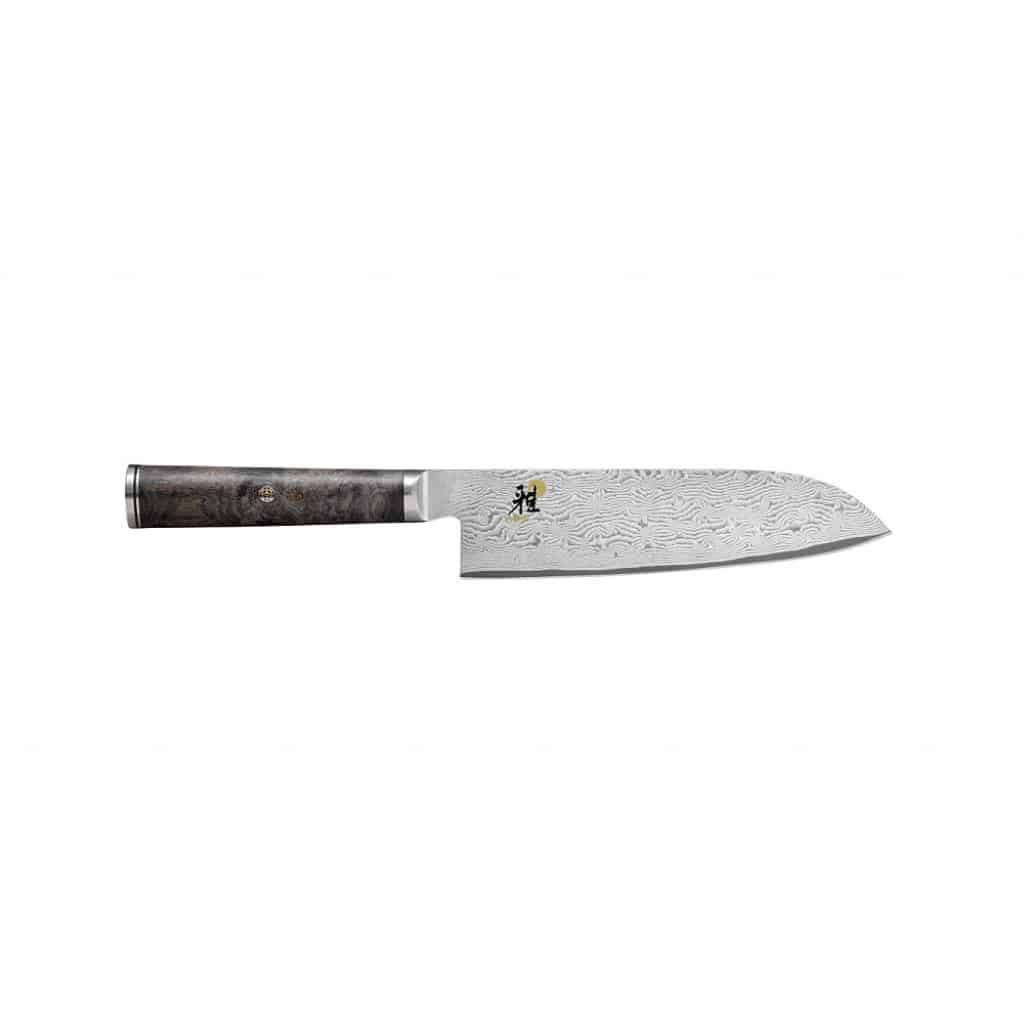
The Santoku is a culinary favorite due to many things. The Granton, which is the scalloped side does enable loosening of the food from the knife. Usually 7” is a great number in terms of length, again for feel and touch with wrist movement for the task at hand (no pun intended).
Our favorite Santoku comes from the best of both worlds. Zwilling Group Brand, the great German company, has a factory in Japan who created this beautiful knife in the time honored Japanese tradition of knife making. The D-Shaped handle made of black ash wood, to the Cryodur, a high carbon, high chromium steel that is nestled in between 132 layers of prestige stainless steel. The hand polishing creates a one of a kind flower Damascus design unique to each Miyabi 5000 MCD 67 7” Santoku Knife. This knife is simply one of the best on the market today.
And, now for “The King of Knives: The Chef’s Knife”. This is the go-to for almost everything. Typically, 8 inches in length up to 14 inches in length. The longer blade allows for longer strokes with cutting. This knife was known as the beef knife. Due to its heaviness, the chef’s knife can cut through bone the best of any utility kitchen knife. The double beveled edge cuts evenly through delicate foods well.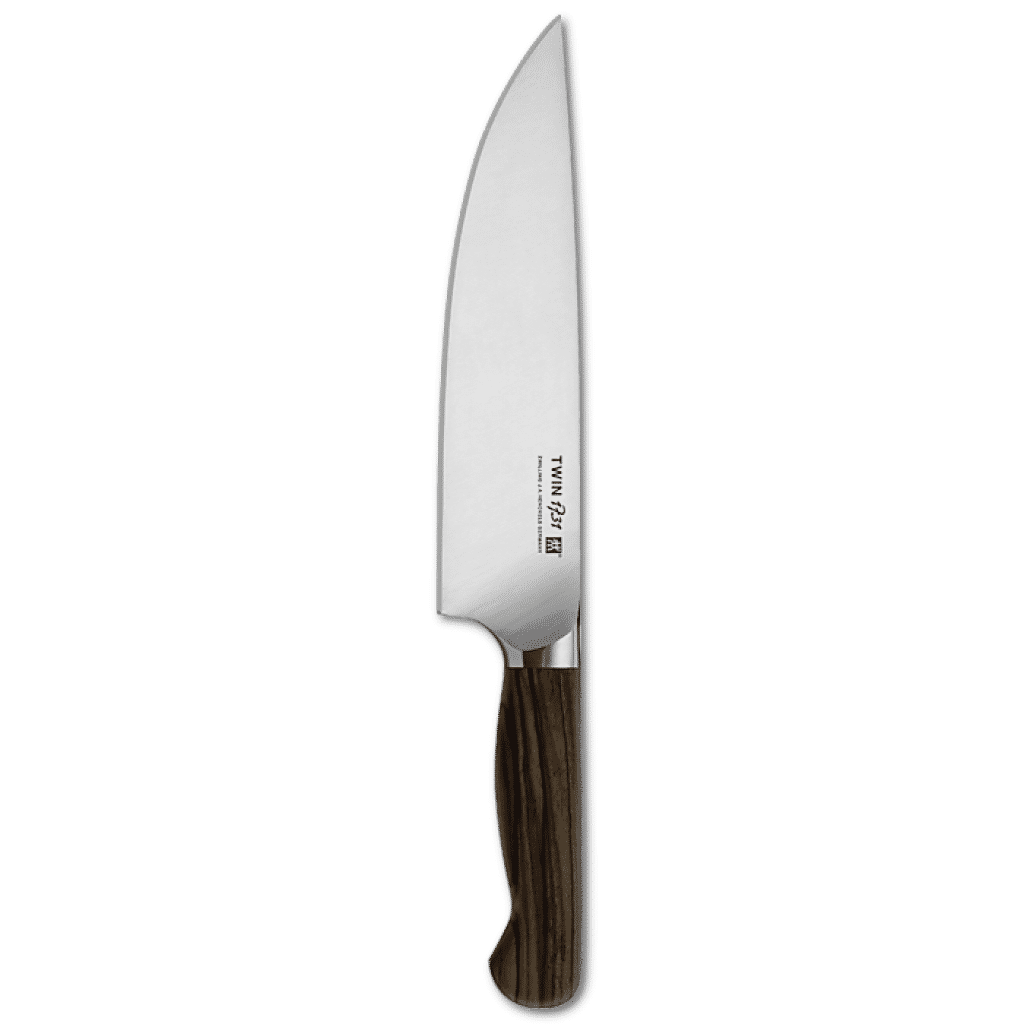
One knife we have not discussed is the French Chef's Knife. The differences between a French and Japanese style knife compared to the German knife are curves. German knives tend to have a more curved section at the front of the blade. This ‘curve’ makes the knife good for chopping in an up-and-down "rocking" motion. This can be an asset to a professional as they are able to chop and dice quickly. The French style is straighter, and more triangular, which is good for a "slicing" type of motion where the knife is drawn straight back toward you. The Japanese-style Santoku knife has hollow, beveled indentations ground into the blade. These are designed to create tiny pockets of air between the knife and the product being sliced, reducing friction and minimizing sticking.
A few personal favorites is The Zwilling J.A. Henckels - 8" Twin 1731 Chef's Knife. The new bolster shape keeps your hand and wrist comfortable with exceptional balance. The cutting edge is ridiculously sharp due to the utilization of Cronidur 30 Steel. Staying razor sharp is easily obtained with a 60 rating on the Rockwell hardness scale. Pinch or hand grip techniques feel natural due to this knife’s full, visible tang.
The Eastern style is depicted beautifully with the Global NI Series Oriental Cooks 8” Knife. This Japanese styled knife brings true pleasure when chopping, slicing, and dicing. They state their knives are like an extension of your hand. The late, great Tony Bourdain loved his Global knifes.
The Chef’s Knife’s little buddy is the Paring Knife. This knife is around 3 to 5 inches long. The same facts apply with the Paring Knife. Le Creuset, a French company has team up in Solingen
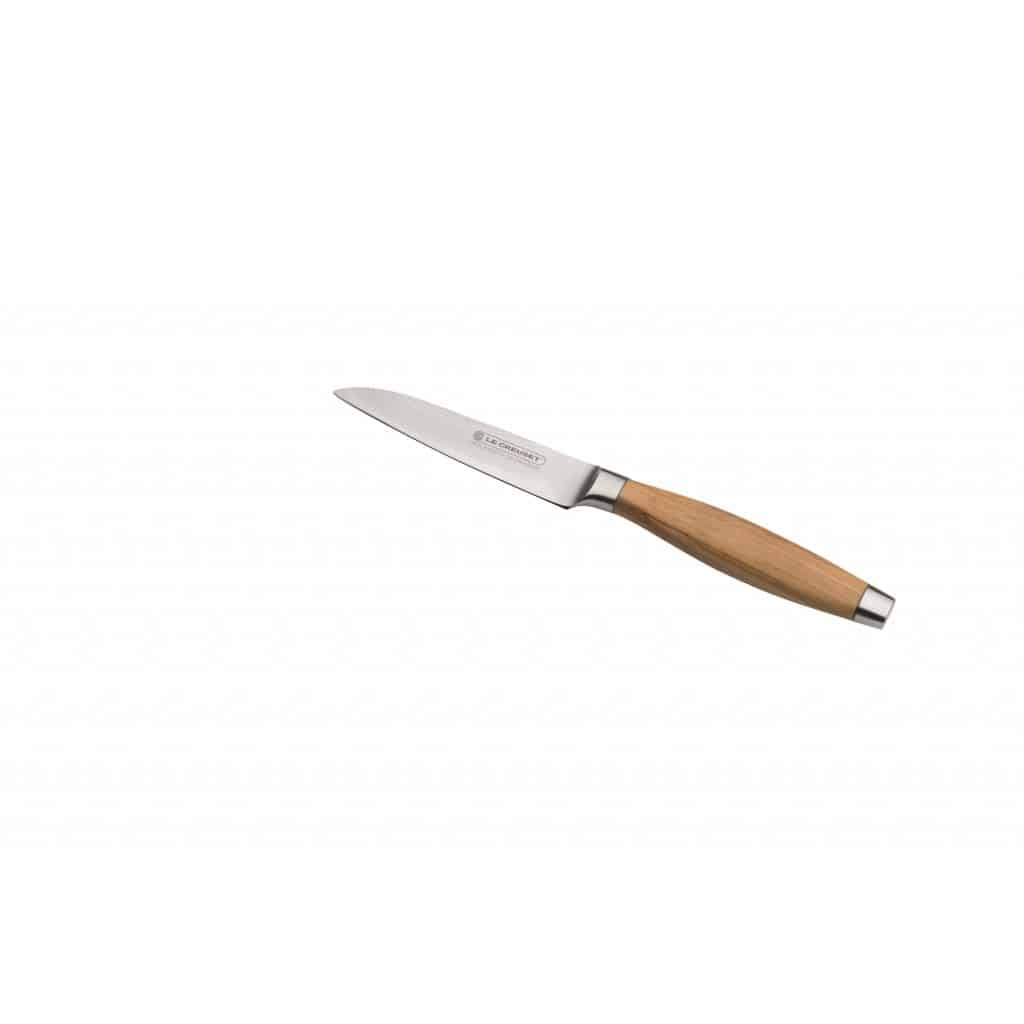 Germany with their friends to create a beautifully mastered, Paring Knife. The Le Creuset Olive Wood 3.5” Paring Knife goes through 40 steps from raw materials to a work of art! A VG10 Steel core with 64 layers of forged Damascus Steel ensures this is one of the sharpest knives out there. Depending on your preference will determine whether an Eastern or Western styled knife should be purchased. Peeling, slicing, fine dicing, and hulling out fruits and vegetables are just a few responsibilities of the Paring Knife.
Germany with their friends to create a beautifully mastered, Paring Knife. The Le Creuset Olive Wood 3.5” Paring Knife goes through 40 steps from raw materials to a work of art! A VG10 Steel core with 64 layers of forged Damascus Steel ensures this is one of the sharpest knives out there. Depending on your preference will determine whether an Eastern or Western styled knife should be purchased. Peeling, slicing, fine dicing, and hulling out fruits and vegetables are just a few responsibilities of the Paring Knife.
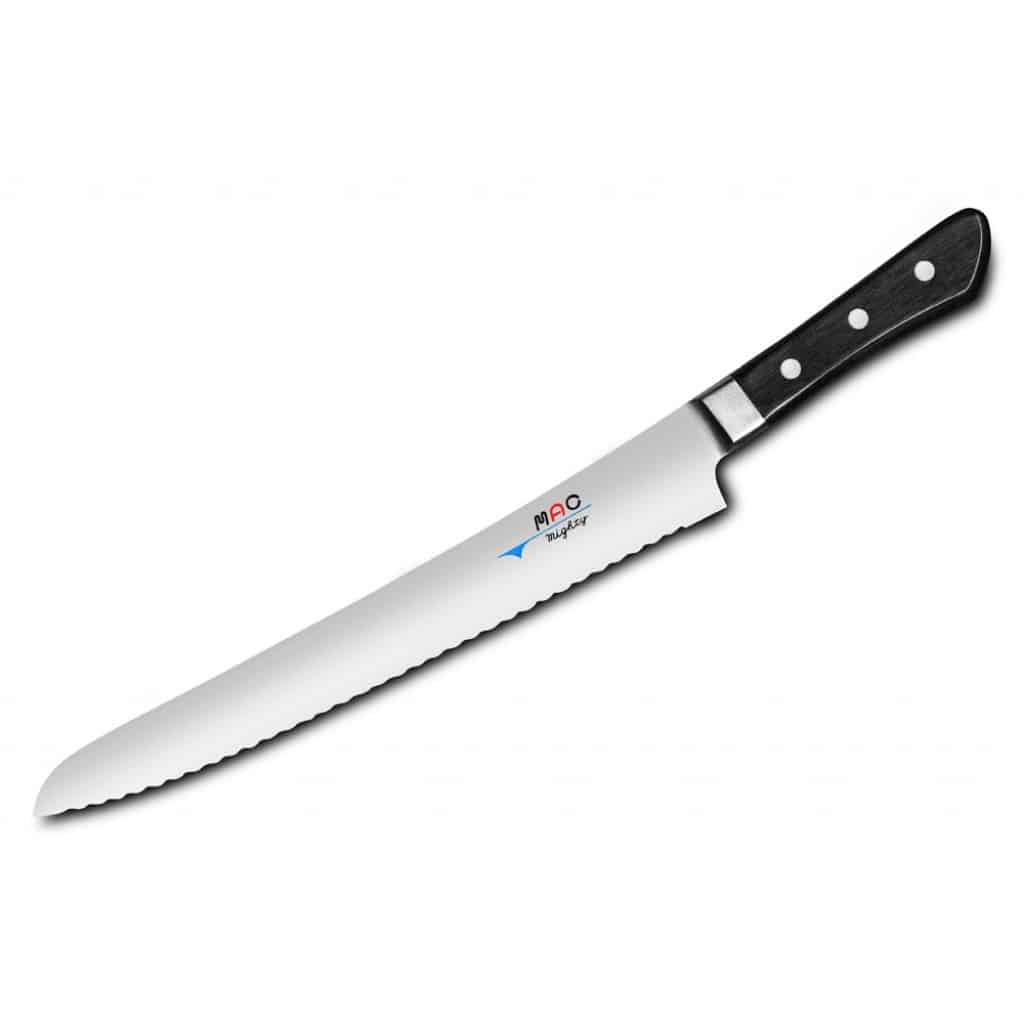
Now on to the good’ol Bread Knife. Just as one would think, these guys are made for not hurting the precious, fluffy insides of your crusty bread loaf. This knife also doubles as a slicer for meats in some versions. The MAC 10.5” Pro Series Bread/ Roast Slicer does the trick from bread to meat. The scalloped serrations ensure wafer-thin slices of the crustiest of breads, and the thinnest sliced ham sandwiches ever!
The Bread knife’s partner in crime is the Slicing or Carving Knife. And, The Wusthof 9” Epicure Carving Knife is surely one of the top rated! A wide shaped blade allows the knife to glide through meats effortlessly. The newly designed bolster adds to
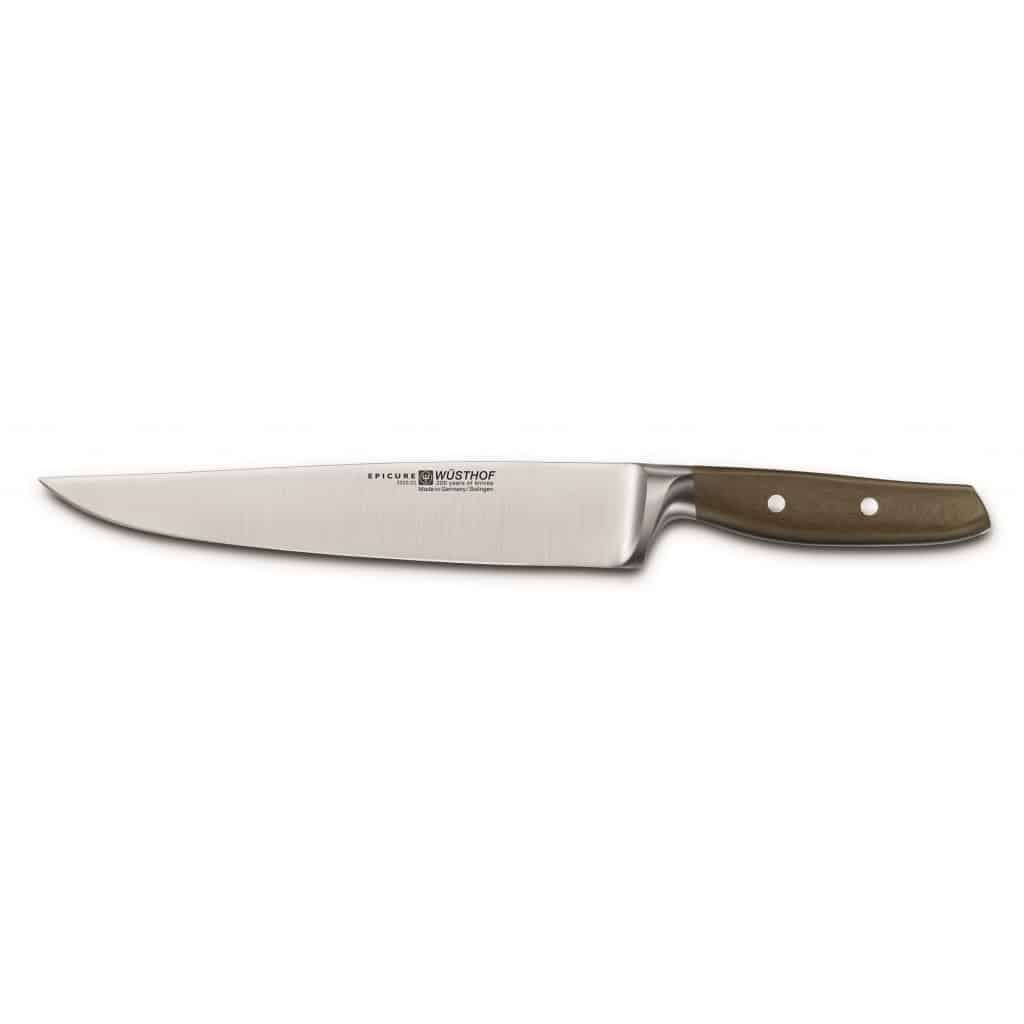
the flawless weight distribution. This is the knife where East meets West in a masterful blend of both designs. A laser is run for proper measurements via the PEtec proprietary process before grinding to an angle of 15 of ultimate sharpness.
After purchasing knives, make sure to keep them sharpened as not to ruin them. There are many ways of sharpening the blade, a few suggestions are:
- Professional
- Whetstone
- Steel (or Hone)
- Manual Sharpener
- Electric Sharpener
- Taking it to a pro, the knife will be done correctly, yet costly…
- Whetstone is a great way to sharpen a knife. You will need to be skilled in holding the knife at the perfect angle to sharpen the blade. A Whetstone can also restore a really dull knife with time and skill…Try the Kasumi Fine/Superfine Combo Whetstone. It is purely a great way to sharpen all of your knives in your collection.
- A Steel or Hone really doesn’t bring a dull knife to life, but should be used as a preventative maintenance device. A Steel or Honing Rod keeps a knife sharp and should be used frequently. There are some diamond sharpening steels that do remove more metal than most such as The Global 10” Diamond Sharpening Steel or The Winco 12” Diamond Sharpening Steel is great for everyday use.
- A manual sharpener is a preferred, cost effective way to keep those knives razor-sharp. The Chef’s Choice Pro Diamond Hone Angle Select 3-Stage Manual Sharpener is a great solution! On Sale at $49.99! Every kitchen needs this sharpener!
- An electric sharpener is a great solution for those who want accurate results quickly. The Chef’s Choice 3-Stage 1520 Angle Select Electric Knife Sharpener is the ultimate! 100% Diamond abrasives and polishing discs.
Remember - always keep your knives in the sheath it came with. Or hang on a Wusthof 18” Magnetic Holder. Wash with warm, soapy water and dry them. Visiting Williams Food Equipment store is advantageous to the knife buyer as you are able to get a feel for the type of knife you want and speaking with our qualified staff will ensure a great decision. Our return policy is second to none if not fully satisfied!
Have fun cutting, slicing, dicing, chopping, peeling, coring and all that you do with the knife you choose. The techniques are important and exciting to learn. Handling sharp equipment confidently and successfully is stimulating to the cook’s soul! Remember, purchasing a knife is a personal decision!

